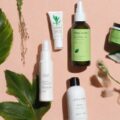Understanding Skin Care Ingredients
When searching for skin care products, you’re bound to encounter an array of unfamiliar ingredients. Deciphering ingredient labels can feel overwhelming, but educating yourself on common components can help simplify the process.
Rather than aimlessly searching for miracle products, focus first on understanding your skin type and concerns. Learn what ingredients target your specific needs. Then look for those key components on product labels.
Approach new products positively but critically. Avoid fear-mongering about “toxic” ingredients. Nearly all components approved in skin care products have been rigorously tested for safety. However, some ingredients work better for certain skin types than others.
Common Beneficial Ingredients
Here are some research-backed ingredients to look for based on your skin goals:
Dry skin: Ceramides, hyaluronic acid, glycerin
Oily/acne-prone skin: Benzoyl peroxide, retinoids, niacinamide
Anti-aging: Retinoids, vitamin C, peptides
Sensitive skin: Colloidal oatmeal, aloe, chamomile
Brightening: Vitamin C, alpha arbutin, licorice root extract
Understanding the INCI
Ingredient lists use standardized scientific names, known as INCI names. This allows consumers to identify ingredients despite branding differences. Don’t let the complex names intimidate you. Watch for key words indicating beneficial components. Google any unfamiliar ingredients for more details.
Evaluating Safety
While most permitted ingredients are well-studied for safety, controversy occasionally surrounds certain compounds. If an ingredient concerns you, look beyond alarmist headlines to find research-based perspectives. Evaluate multiple credible sources to gauge if potential risks outweigh benefits. Remember that concentration also impacts safety thresholds.
Seeking Sustainable Choices
Environmental and ethical concerns also drive some consumers towards “clean” products. Seek out brands that align with your values, but remember there’s no official clean standard. Transparent brands that disclose sources and practices are more likely to reassure conscientious shoppers.
Empowering Informed Decisions
Skin care doesn’t have to be confusing with the right education and perspective. Focus less on fear and more on understanding your skin and its needs. Then seek products delivering key ingredients to address your concerns. A little awareness goes a long way towards simplifying your search for your ideal routine.
FAQ:
What are the best ingredients for dry skin?Some excellent ingredients for hydrating dry skin are ceramides, hyaluronic acid, glycerin, plant oils, dimethicone, and shea butter. Look for products containing several of these for optimal effects.
Do I need to avoid parabens? Parabens are highly studied preservatives considered safe by health authorities in permitted concentrations. Unless you’re sensitive to parabens, avoiding them eliminates many affordable, efficacious products with no added benefit.
What are some clean beauty brands I can trust?Popular clean brands striving for safe, sustainable products include Beautycounter, Biossance, Versed, Saie, and The Ordinary. However, clean standards vary greatly, so research any unfamiliar brands.
Should I only use natural ingredients on my skin? “Natural” labels don’t guarantee safety or efficacy. Many plant compounds cause reactions, while several safe synthetic ingredients outperform natural alternatives. Carefully examine product details instead of making assumptions.
What should I look for to even my skin tone? Key ingredients that may gradually reduce signs of uneven pigmentation include vitamin C, alpha arbutin, azelaic acid, niacinamide, licorice root extract, and chemical exfoliators like AHAs and BHAs.









